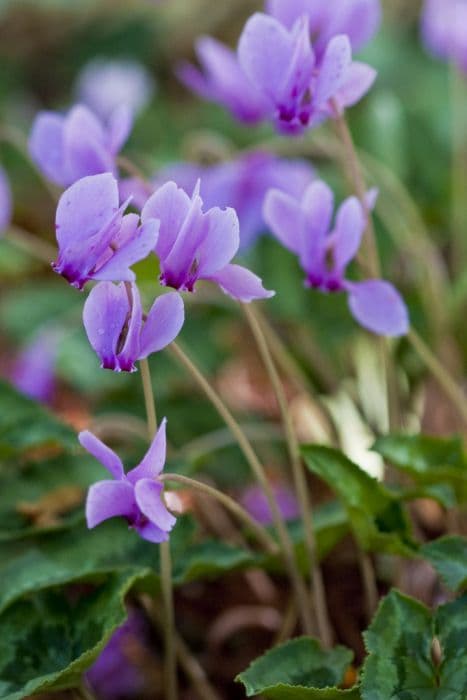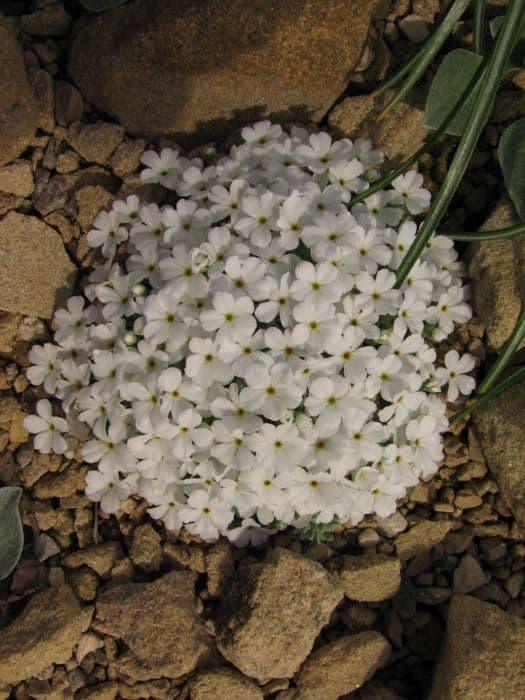African Cyclamen Cyclamen africanum

ABOUT
Cyclamen africanum, commonly known as African Cyclamen, displays a distinctive and attractive appearance. The plant features heart-shaped, dark green leaves that are often marbled with lighter shades or silver patterns, giving them a decorative look. The foliage forms a low-growing mound with the leaves arising on individual stems from the base of the plant. The flowers of African Cyclamen are particularly striking and are borne on long stalks that rise above the foliage. These blooms are characterized by their swept-back petals, which resemble a group of tiny, elegant butterflies hovering over the leaves. The color of the flowers can range from soft pinks to rich magentas, with a distinctive darker color at the base of the petals, often appearing as a nose-like protrusion. Additionally, the plant produces a tuber from which the leaves and flower stems grow. This tuber is typically rounded, and as the plant matures, it becomes more pronounced and can occasionally be seen slightly above the soil surface. Although commonly grown as a houseplant, the African Cyclamen's ornamental qualities make it a popular choice for adding a splash of color to indoor environments, with its vibrant flowers and patterned foliage creating a visually appealing display.
About this plant
 Names
NamesFamily
Primulaceae
Synonyms
African Cyclamen, Algerian Cyclamen
Common names
Cyclamen africanum.
 Toxicity
ToxicityTo humans
Cyclamen, specifically Cyclamen africanum, contains toxic compounds such as terpenoid saponins which can be harmful if any part of the plant, including tubers and leaves, is ingested. Symptoms of poisoning may include gastrointestinal upset such as vomiting and diarrhea, as well as abdominal pain. In severe cases, ingestion may lead to heart rhythm abnormalities, seizures, and systemic complications which could be life-threatening.
To pets
Cyclamen is also toxic to pets, including cats and dogs, and can cause similar symptoms as in humans. If a pet ingests any part of the cyclamen plant, they may experience drooling, vomiting, diarrhea, and a decrease in appetite. More serious complications can also occur, which may include heart problems, seizures, and potentially even death if not treated promptly.
 Characteristics
CharacteristicsLife cycle
Perennials
Foliage type
Evergreen
Color of leaves
Variegated
Flower color
Pink
Height
6 inches (15 cm)
Spread
6 inches (15 cm)
Plant type
Bulb
Hardiness zones
9
Native area
Tunisia
Benefits
 General Benefits
General Benefits- Aesthetic Appeal: Cyclamen africanum, also known as North African cyclamen, has beautiful heart-shaped leaves and colorful flowers that enhance the visual appeal of any garden or indoor space.
- Seasonal Interest: It blooms in late summer and autumn, providing color and interest during a time when many other plants have finished flowering.
- Easy Care: This cyclamen species is relatively low-maintenance, requiring minimal care once its basic needs for light and water are met.
- Compact Growth: With its compact size, Cyclamen africanum is suitable for smaller gardens or as a houseplant where space is limited.
- Long Blooming Period: The plant features a long blooming period that can last several weeks, offering a prolonged display of its vibrant flowers.
- Drought Resistance: North African cyclamen is quite drought-tolerant once established, making it a good choice for water-wise gardens.
- Cool Weather Tolerance: It thrives in cooler temperatures and can be an excellent plant for adding color in fall and early spring when other plants may struggle.
- Perennial Lifespan: As a perennial, Cyclamen africanum will come back year after year, making it a sustainable and long-lasting choice for gardeners.
 Medical Properties
Medical PropertiesThis plant is not used for medical purposes.
 Air-purifying Qualities
Air-purifying QualitiesThis plant is not specifically known for air purifying qualities.
 Other Uses
Other Uses- Cyclamen africanum tubers have been used to make a soap-like lather for cleaning. The tubers contain saponins that when mixed with water can produce a frothy solution.
- The plant is often used in horticulture as a parent in hybridization to create new ornamental varieties with unique characteristics.
- It can be used as an educational tool in botanical studies to understand the adaptability and evolution of plant species in Mediterranean environments.
- Due to its aesthetic appeal, Cyclamen africanum is commonly utilized in photography and botanical illustrations that focus on natural beauty and plant structure.
- In certain cultures, the plant is used symbolically in festivals and traditions to represent love and tenderness because of its heart-shaped leaves and attractive flowers.
- The vivid and distinct flowers of Cyclamen africanum are sometimes used in artistic compositions and floral designs for their unique shape and color.
- Its ability to thrive in shady areas makes it a preferred choice among gardeners for underplanting beneath deciduous trees or larger shrubs.
- Cyclamen africanum's leaves, with their variegated patterns, are sometimes used in pressed plant art and crafts due to their decorative appearance.
- During dormant periods, the dried tubers have been used creatively as eco-friendly ornaments or components in rustic decorations.
- The plant has been used as a natural marker of the seasons by horticulturists and garden enthusiasts due to its specific flowering period signaling the end of summer and beginning of autumn.
Interesting Facts
 Feng Shui
Feng ShuiThe plant Cyclamen is not used in Feng Shui practice.
 Zodiac Sign Compitability
Zodiac Sign CompitabilityThe plant Cyclamen is not used in astrology practice.
 Plant Symbolism
Plant Symbolism- Love and Devotion: Cyclamen often symbolizes sincere love and devotion due to its heart-shaped leaves and beautiful, sweeping flowers that evoke feelings of tender affection.
- Resilience and Strength: As a plant that flourishes in cooler temperatures and can thrive in less than ideal conditions, it represents resilience and the strength to persevere through challenges.
- Goodbye and Parting: In some cultures, Cyclamen is associated with departure or goodbyes because its flowers bend and droop as if bowing in farewell, which makes it a common gift when someone is leaving or moving on.
- Fertility and New Life: The plant is also symbolic of fertility and new life, especially in the spring, as it is one of the early bloomers signaling the arrival of the new season and the cyclical nature of life.
- Healing: Historically, the Cyclamen was believed to have healing properties and thus came to be associated with restoration and physical well-being.
 Water
WaterAfrican cyclamen prefers to be watered from the bottom to prevent water from getting on the leaves and crown, which can lead to rot. You should water them thoroughly when the soil surface feels dry to the touch. Typically, this may mean watering with approximately one quart of water every 7 to 10 days, but this can vary depending on environmental conditions. During the active growing season, keep the soil consistently moist but not waterlogged. During dormancy, which often occurs in the summer, water sparingly, just enough to prevent the soil from completely drying out.
 Light
LightAfrican cyclamen thrives in bright, indirect light. The best spot for the plant would be an east- or north-facing window where it can receive gentle morning light and avoid the harsh afternoon sun. If the light is too strong, the leaves can get scorched, while too little light can cause the plant to become leggy.
 Temperature
TemperatureAfrican cyclamen enjoys cool to moderate temperatures, with ideal conditions ranging from 60 to 75 degrees Fahrenheit. It is tolerant down to about 50 degrees Fahrenheit, but should not be exposed to temperatures above 77 degrees for prolonged periods. The plant benefits from a temperature drop at night of about 5 to 10 degrees to mimic its natural habitat.
 Pruning
PruningPrune African cyclamen by removing yellowed or withered leaves and spent flowers to encourage new growth and to maintain plant health. This should be done as needed throughout the growing season. After blooming, reduce watering to allow the plant to go into dormancy, then trim off any remaining old leaves to make room for new growth, which typically occurs in fall.
 Cleaning
CleaningAs needed
 Soil
SoilFor Cyclamen africanum, often simply known as the African cyclamen, the best soil mix would be one that is well-draining and rich in organic matter. A suitable mix can be made from equal parts of potting soil, perlite or sand, and peat or coir. The ideal soil pH for the African cyclamen should be slightly acidic to neutral, ranging between 6.0 and 7.0.
 Repotting
RepottingAfrican cyclamen should generally be repotted every one to two years or when the plant has outgrown its current container. Repotting is ideally done when the plant is dormant, typically in summer after the leaves have died back.
 Humidity & Misting
Humidity & MistingAfrican cyclamen prefers moderate to high humidity conditions. The optimal humidity level should range between 40% and 70%. Consistent humidity is important but be cautious to avoid overly wet conditions which can lead to rot.
 Suitable locations
Suitable locationsIndoor
Place African cyclamen in bright, indirect light with cool temperatures.
Outdoor
Grow in shaded area, protect from intense heat and frost.
Hardiness zone
9-11 USDA
 Life cycle
Life cycleCyclamen africanum, commonly known as African cyclamen, begins its life cycle when seeds are sown in a well-drained medium, ideally during fall. Upon germination, seedlings develop into small plants featuring heart-shaped leaves, and as they mature, the tuber grows and multiplies beneath the soil surface. The growth period continues with the production of flowers, typically from late summer to autumn, which are characterized by their unique upward-sweeping petals, varying in shades from white to pink or crimson. After pollination, typically by insects, the plant sets seed encapsulated in a pod, which will eventually dry and release the seeds to start a new generation. During late spring or early summer, the leaves start to yellow and the plant enters dormancy to cope with the hot, dry Mediterranean summer climate where it originates. Post dormancy, as temperatures cool and moisture increases, the cyclamen resumes its cycle with the emergence of new foliage, anticipating the next flowering phase.
 Propogation
PropogationPropogation time
Spring-Early Summer
Cyclamen africanum, commonly known as African cyclamen, is typically propagated through seed. The best time to sow seeds is in late summer or early fall. To propagate by seed, soak the seeds for 12 to 24 hours in water to soften the tough seed coat. Sow them in a well-draining seed starting mix, covering lightly with soil. The medium should be kept moist but not waterlogged, and the seeds usually germinate within a month or two during fall when the temperatures are cooler. Once seedlings have developed a few sets of leaves, they can be carefully transplanted into individual pots. This method may take several years to produce flowering plants, but it is the most reliable way to propagate Cyclamen africanum.








![Primrose [Belarina Amethyst Ice]](/_next/image?url=https%3A%2F%2Fplants-admin.emdemapps.com%2Fimages%2Fplants%2F%2Fimages%2F604b59c727782.png&w=640&q=75)
